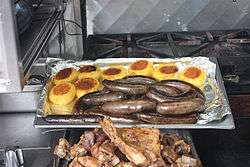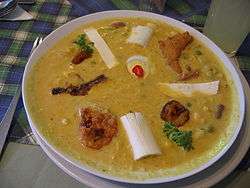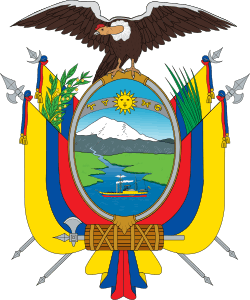Ecuadorian cuisine

| Part of a series on the |
| Culture of Ecuador |
|---|
 |
| History |
| People |
| Languages |
| Cuisine |
| Religion |
| Art |
|
Music and performing arts |
|
Media |
| Sport |
|
Ecuadorian cuisine is diverse, varying with altitude, and associated agricultural conditions. Beef, chicken, and seafood are popular in the coastal regions and are typically served with carbohydrate-rich foods, such as rice accompanied with lentils, pasta, or plantain. Whereas in the mountainous regions pork, chicken, beef and cuy (guinea pig) are popular and are often served with rice, corn, or potatoes. A popular street food in mountainous regions is hornado, consisting of potatoes served with roasted pig. Some examples of Ecuadorian cuisine in general include patacones (unripe plantains fried in oil, mashed up, and then refried), llapingachos (a pan-seared potato ball), and seco de chivo (a type of stew made from goat). A wide variety of fresh fruit is available, particularly at lower altitudes, including granadilla, passionfruit, naranjilla, several types of banana, uvilla, taxo, and tree tomato.
The food is somewhat different in the southern mountainous areas, featuring typical Loja food such as repe, a soup prepared with green bananas; cecina, roasted pork; and miel con quesillo, or "cuajada", as dessert. In the rainforest, a dietary staple is the yuca, elsewhere called cassava. The starchy root is peeled and boiled, fried, or used in a variety of other dishes. Across the nation it's also used as a bread, pan de yuca which is analogous to the Brazilian pão de queijo and its often consumed alongside different types of drinkable yogurt. Many fruits are available in this region, including bananas, tree-grapes, and peach-palms.
Typical meal
Most regions in Ecuador follow the traditional 3 course meal of sopa/soup and segundo/second dish which includes rice or pasta and a protein such as meat, poultry, pig or fish. Then dessert and a coffee are customary. Dinner is usually lighter and sometimes just coffee or agua de remedio/herbal tea with bread.
For the most part, Ecuador is known not only for its bananas, and all the dishes made from them, but for its starch consumption of products like potato, bread, pasta, rice, and yuca. Traditionally any of these ingredients can be found in either the soup or the rice platter that may be served.
Beverages
Aguardiente, a sugar cane-based spirit, is probably the most popular national alcohol. Canelazo is a popular drink made from aguardiente. Drinkable yogurt, available in many fruit flavors, is popular and is often consumed with pan de yuca (a puffy yet gooey bread roll made from cassava flour eaten hot). One traditional non-alcoholic beverage is pinol, made using machica (toasted barley flour), panela (unrefined sugar), and spices.[1] Another traditional non-alcoholic beverage is colada morada, which is made with black corn flour, sweetened with panela, and flavored with fresh fruit, herbs and spices.
Catholic influence
Besides the regions, there are several typical Ecuadorian dishes consumed on special occasions. Fanesca, a fish soup including several types of beans, lentils, and corn, is often eaten during Lent and Easter, and is traditionally served all over Ecuador. During the week before the commemoration of the deceased or All Souls' Day, the fruit beverage colada morada is typical, accompanied by t'anta wawa which is stuffed bread shaped like children.
See also
References
- ↑ "Artesanos de 7 cantones expusieron en Salcedo" [Craftspeople of 7 cantons exhibited in Salcedo]. El Telégrafo (in Spanish). 9 September 2014. Retrieved 14 October 2015.
Otra elaboración tradicional que se degustó fue el pinol, realizado con máchica, panela, canela y clavo de olor, entre otros ingredientes de la zona.
["Another traditional product tasted was pinol, made with máchica, panela, cinnamon and cloves, among other local ingredients."]

